 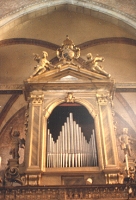 The Seventeenth and Eighteenth Centuries
|
| Appearance | Enlarged Photographs | Review Quiz |
In contrast to developments in England, France and Germany, the Italian organ changed very little from around 1600 until the end of the eighteenth century. The typical Italian instrument of the period inherited most of its characteristics from the sixteenth century:154
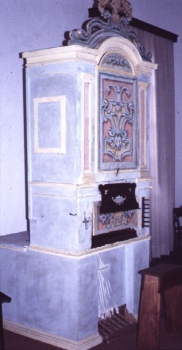 The seventeenth-century instrument in the photograph to the right is in many ways typical of the small instruments built in Italy from the sixteenth through the eighteenth centuries.155 This view shows a cover in place over the pipes. Panels of this type, or sometimes curtains, remained common in Italy long after the folding doors of northern organs were no longer made.
The seventeenth-century instrument in the photograph to the right is in many ways typical of the small instruments built in Italy from the sixteenth through the eighteenth centuries.155 This view shows a cover in place over the pipes. Panels of this type, or sometimes curtains, remained common in Italy long after the folding doors of northern organs were no longer made.
Even with the cover in place, the stop controls and the keyboard are visible. The stop controls, to the right of the keyboard, work in the usual way on instruments of this small size. They move from side to side rather than pulling out from the case.
The projection at the rear of the case houses the bellows, operated by means of ropes attached to the mechanism and extending through the housing.
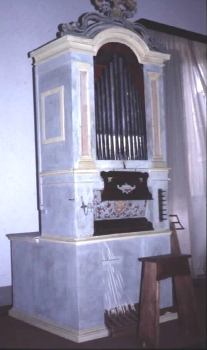 In this photograph, the housing has been removed, and you can see the pipes of the Principale arranged in a common symmetrical pattern. Although stopped pipes were not common in Italy, even in the seventeenth-century, this particular organ has an 8' Principale whose first six pipes are stopped. The compass of the single manual is C - f''', with a short octave in the bass. The first octave of the Principale is not visible.
In this photograph, the housing has been removed, and you can see the pipes of the Principale arranged in a common symmetrical pattern. Although stopped pipes were not common in Italy, even in the seventeenth-century, this particular organ has an 8' Principale whose first six pipes are stopped. The compass of the single manual is C - f''', with a short octave in the bass. The first octave of the Principale is not visible.
The stoplist of this instrument is typical of this type of small organ, consisting of these ripieno stops:
| Principale | 8' | |
| Quintadecima | 2' | |
| Decimanona | 1 1/3' | |
| Vigesimaseconda | 1' | |
| Vigesimasesta | 2/3' |
In the usual way, the higher-pitched stops break in the upper octave, starting on g#'. Even the 2' breaks to 4' pitch at that point. Perhaps the only unusual stop on the organ is a Voce humana, unusual not in its presence, but in its starting pitch (g#), which is lower than usual.154
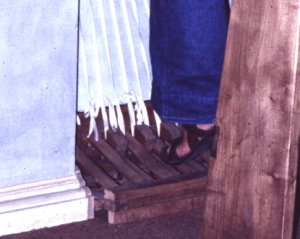 The pedals of this organ are also typical of the type. As you can see in the photograph to the right, they are made as short levers pivoted at their outermost point and placed at a rising angle as they extend toward the case. In this particular instance, the fabric ties that connect the pedals to the lower keys of the manual are visible. In other instruments they might be hidden behind the kickboard. In either case, Italian pedals provide the most obvious examples of "pull-down" pedals you are likely to find anywhere.
The pedals of this organ are also typical of the type. As you can see in the photograph to the right, they are made as short levers pivoted at their outermost point and placed at a rising angle as they extend toward the case. In this particular instance, the fabric ties that connect the pedals to the lower keys of the manual are visible. In other instruments they might be hidden behind the kickboard. In either case, Italian pedals provide the most obvious examples of "pull-down" pedals you are likely to find anywhere.
In this organ there is no independent pedal rank; only the stops that are drawn on the manual will play. On other organs, even small ones such as this, there might be a ten or twelve-pipe 8' stop that always plays from the pedals. In a larger instrument, a 16' stop, or even two stops (16' and 8') could be present. Even in a case like that, however, there would normally be no stop controls, and the pedal ranks would always sound when the pedals were played.
Of course, even though most organs continued to be built according to Italian traditions, there were exceptions. Not surprisingly, some of these exceptions are found in the north, where builders from northern Europe were active. Look at this stoplist, from an organ built in 1694 in Maia Bassa in northern Italy.156
| Principale | 8 | Superottava | 2 | |||
| Gedackt | 8 | Waldflöte | 2 | |||
| Fiffaro | 8 | Decimanona | 1 1/3 | |||
| Coppel | 8 | Vigesimaseconda | 1 | |||
| Ottava | 4 | Vigesimasesta | 2/3 | |||
| Offenflöte | 4 | Cymbal II | ||||
| Nachthorn | 4 | Mixtur II | ||||
| Spitzflöte | 2 | Cornetti III | ||||
| Gemsflöte | 2 |
The organ was built by Johann Caspar, a transalpino who was called "Eugenio Casparini" by the Italians. Some of the stops are to be expected in an Italian instrument:
Although several of these stops would never be seen in other Italian organs, the Cornetti actually became quite common. Sometimes appearing with its name in the singular (Cornetto), this was a Cornet-type compound stop, not a reed.
Even though this instrument had a large number of Germanic stops, it was not the only one. Other instruments from the north were built with a few such unusual registers, and some of them even had multiple manuals. For the most part, however, the Italian organ remained a single-manual instrument well into the nineteenth century.
In the basic design of its case, the Italian organ maintained its traditional shape of a single rectangular enclosure on a base whose sides extended straight down to the floor. The façade of the case was then given a Roman arch shape, with straight sides topped with a semi-circular curve. But the use of this basic shape didn't stop builders from elaborating on it in individual instruments. In fact, the basic box with arch was commonly modified in one of two ways.
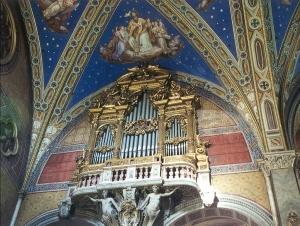 The
first alteration is found in the treatment of the basic shape as
a platform for sculptural elaboration. For example, look at the
the photograph on the right, which shows one of the two organs in
the Basilica of Santa Maria Sopra Minerva in Rome. As you look at
it, imagine it with the gilded sculpture removed. What's left is
a basic box shape, isn't it?
The
first alteration is found in the treatment of the basic shape as
a platform for sculptural elaboration. For example, look at the
the photograph on the right, which shows one of the two organs in
the Basilica of Santa Maria Sopra Minerva in Rome. As you look at
it, imagine it with the gilded sculpture removed. What's left is
a basic box shape, isn't it?  The
elaborate curlicues, putti, and cloud shapes are not unlike those
you see in the works of Bernini. In fact, look at this photograph
of the sculptural elements he added around the window behind St.
Peter's Chair in St. Peter's Basilica, in the Vatican. Both the
sculpture and the organ case -- by an unremembered artist -- date
from the first half of the sixteenth century. Both are filled with
motion, in the best tradition of the early Baroque in the visual
arts. So -- this is one way the Italian "box case" was
elaborated upon in the seventeenth and eighteenth centuries. It
became a sculpture in its own right. The presence of actual pipes
in the façade almost seems to be an afterthought.
The
elaborate curlicues, putti, and cloud shapes are not unlike those
you see in the works of Bernini. In fact, look at this photograph
of the sculptural elements he added around the window behind St.
Peter's Chair in St. Peter's Basilica, in the Vatican. Both the
sculpture and the organ case -- by an unremembered artist -- date
from the first half of the sixteenth century. Both are filled with
motion, in the best tradition of the early Baroque in the visual
arts. So -- this is one way the Italian "box case" was
elaborated upon in the seventeenth and eighteenth centuries. It
became a sculpture in its own right. The presence of actual pipes
in the façade almost seems to be an afterthought.
 The second way in which the basic Italian case was modified was by treating it in an architectural manner. Look at this case, the organ in the Cathedral of Orvieto. Once again, the pipes seem almost secondary, just as they do in the case above. But this time the method of elaboration is a little different.
The second way in which the basic Italian case was modified was by treating it in an architectural manner. Look at this case, the organ in the Cathedral of Orvieto. Once again, the pipes seem almost secondary, just as they do in the case above. But this time the method of elaboration is a little different. 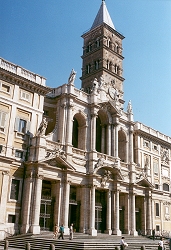 In the other organ, the structure of the case itself -- the "box," as I've been calling it -- was overlaid so much with sculpted shapes that it was difficult to see it. In this instance, though, the straight lines of the "box" are obvious. In fact, they've actually been emphasized by the treatment here, so that they've taken on the appearance of the columns and arches you would find in a Baroque building. In fact, the closest thing you'll find in Italian history to this design is something like the Baroque porch added to the Basilica of Santa Maria Maggiore in Rome -- in the photograph to the left. In the organ case, there are pipes, not doors, between the columns, but the rest of the designs are strikingly similar.
In the other organ, the structure of the case itself -- the "box," as I've been calling it -- was overlaid so much with sculpted shapes that it was difficult to see it. In this instance, though, the straight lines of the "box" are obvious. In fact, they've actually been emphasized by the treatment here, so that they've taken on the appearance of the columns and arches you would find in a Baroque building. In fact, the closest thing you'll find in Italian history to this design is something like the Baroque porch added to the Basilica of Santa Maria Maggiore in Rome -- in the photograph to the left. In the organ case, there are pipes, not doors, between the columns, but the rest of the designs are strikingly similar.
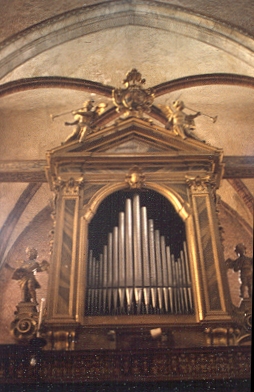 Of
course, not all Italian cases of the seventeenth and eighteenth centuries
looked like the two shown here. As you look at various Italian organs, you'll
see that in the latter part of this period, taste was a little more restrained.
For example, the photograph to the right shows an organ built in 1795 by
G. Callido for the Basilica Dei Frari in Venice, one of the two that are
mounted to the sides and above the choir. For comparison, look at the other
case, shown at the top of this page. It was built by G. B. Piaggia in 1732,
and the similarities between the two cases are striking. In general, Italian
art of the eighteenth century was in some ways more restrained than that
of the first 100 years of the Baroque. Although all of these instruments
show different treatments of the basic case design as a background for sculptural
display, they all illustrate the same basic shape. Only the decorative elements
differ among them.
Of
course, not all Italian cases of the seventeenth and eighteenth centuries
looked like the two shown here. As you look at various Italian organs, you'll
see that in the latter part of this period, taste was a little more restrained.
For example, the photograph to the right shows an organ built in 1795 by
G. Callido for the Basilica Dei Frari in Venice, one of the two that are
mounted to the sides and above the choir. For comparison, look at the other
case, shown at the top of this page. It was built by G. B. Piaggia in 1732,
and the similarities between the two cases are striking. In general, Italian
art of the eighteenth century was in some ways more restrained than that
of the first 100 years of the Baroque. Although all of these instruments
show different treatments of the basic case design as a background for sculptural
display, they all illustrate the same basic shape. Only the decorative elements
differ among them.
The extremely large size of some of these images means that loading them will take an unduly long time if you are viewing these pages through a modem connection.
© 2000, 2001 AD, James H. Cook